
Durga is a major Hindu goddess, worshipped as a principal aspect of the mother goddess Mahadevi. She is associated with protection, strength, motherhood, destruction, and wars.

Diwali is the Hindu festival of lights with its variations also celebrated in other Indian religions. It symbolises the spiritual "victory of light over darkness, good over evil, and knowledge over ignorance". Diwali is celebrated during the Hindu lunisolar months of Ashvin and Kartika—between around mid-September and mid-November. The celebrations generally last five or six days.

Puja is a worship ritual performed by Hindus, Buddhists and Jains to offer devotional homage and prayer to one or more deities, to host and honor a guest, or to spiritually celebrate an event. It may honor or celebrate the presence of special guests, or their memories after they die. The word pūjā is Sanskrit, and means reverence, honor, homage, adoration, and worship. Puja, the loving offering of light, flowers, and water or food to the divine, is the essential ritual of Hinduism. For the worshipper, the divine is visible in the image, and the divinity sees the worshipper. The interaction between human and deity, between human and guru, is called darshan, seeing.
Public Holidays in India, also known as Statutory Holidays, or colloquially Government Holidays, consist of a variety of cultural, nationalistic, and religious holidays that are legislated in India at the union or state levels. While many of these holidays are honored and acknowledged nationwide, state legislation varies regarding which are officially recognized.
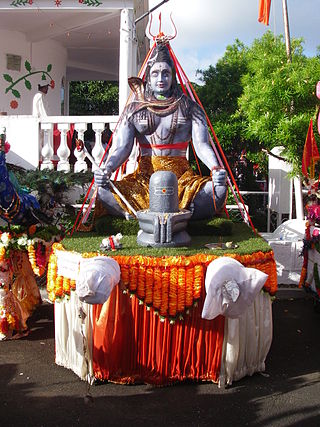
Maha Shivaratri is a Hindu festival celebrated annually in honour of the deity Shiva, between February and March. According to the Hindu calendar, the festival is observed on the fourteenth day of the dark (waning) half of the lunar month of Phalguna or Magha. The festival commemorates the wedding of Shiva and Parvati, and the occasion that Shiva performs his divine dance, called the Tandava.
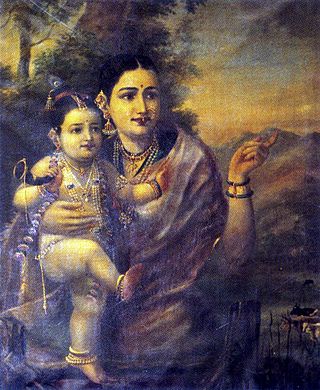
Krishna Janmashtami, also known simply as Krishnashtami,Janmashtami, or Gokulashtami, is an annual Hindu festival that celebrates the birth of Krishna, the eighth avatar of Vishnu. In certain Hindu texts, such as the Gita Govinda, Krishna has been identified as supreme God and the source of all avatars. Krishna's birth is celebrated and observed on the eighth day (Ashtami) of the dark fortnight in Shravana Masa or Bhadrapada Masa. This overlaps with August or September of the Gregorian calendar.
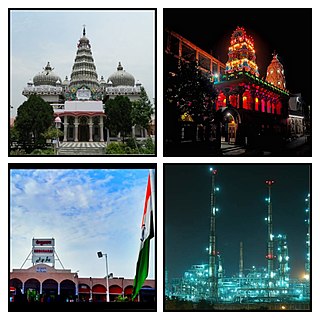
Begusarai is the industrial and financial capital of Bihar and the administrative headquarters of the Begusarai district, which is one of the 38 districts of the Indian state of Bihar. The district lies on the northern bank of the river Ganges in the Mithila region of India.

Chhath is an ancient Hindu festival historically native to the Indian subcontinent, more specifically, the Indian states of Bihar, Uttar Pradesh, Jharkhand, and the Nepalese provinces of Madhesh and Lumbini. Prayers during Chhath puja are dedicated to the solar deity, Surya, to show gratitude and thankfulness for bestowing the bounties of life on earth and to request that certain wishes be granted.

Vishvakarma or Vishvakarman is a craftsman deity and the divine architect of the devas in contemporary Hinduism. In the early texts, the craftsman deity was known as Tvastar and the word "Vishvakarma" was originally used as an epithet for any powerful deity. However, in many later traditions, Vishvakarma became the name of the craftsman god.

Tihar is a five-day Hindu festival celebrated in Nepal and the Indian states of Sikkim and West Bengal, particularly the towns of Darjeeling and Kalimpong, which host a large number of ethnic Indian Gorkha people. Tihar is analogous to the Indian festival of Diwali, the festival of lights, but some significant differences.
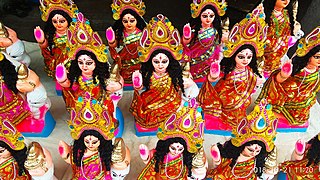
Sharad Purnima is a religious festival celebrated on the full moon day of the Hindu lunar month of Ashvin, marking the end of the monsoon season. The full moon night is celebrated in different ways in various cultural regions across South Asia.

Gita Mahotsav,Gita Jayanti, also known as Mokshada Ekadashi or Matsya Dvadashi is a Hindu observance that marks the day the Bhagavad Gita dialogue occurred between Arjuna and Krishna on the battlefield of Kurukshetra. It is celebrated on Shukla Ekadashi, the 11th day of the waxing moon of the lunar month Margashirsha (December–January) of the Hindu calendar. The Bhagavad Gita forms a part of the epic Mahabharata and the text is structurally divided into 18 chapters, containing 700 shlokas or couplets. It is told in the third person, narrated by Sanjaya to King Dhritarashtra as it transpired between Krishna and Arjuna. Sanjaya, the scribe of the blind King Dhritarashtra, was blessed by Vyasa, with the power to remotely view the events taking place on the battlefield as they transpired.

Ekadashi is the eleventh lunar day (tithi) of the waxing and waning lunar cycles in a Vedic calendar month. Ekadashi is popularly observed within Vaishnavism, a major denomination within Hinduism. Followers offer their worship to the god Vishnu by fasting.

Teej, literally meaning the "third" denoting the third day after the new moon when the monsoon begins as per the Hindu calendar, is a combined name for 3 Hindu festivals primarily dedicated to Hindu deities - the mother goddess Parvati and her male consort Lord Shiva, mainly celebrated by married women & unmarried girls mostly in North India and Nepal to wish for the long life of their husband or future husband and to welcome the arrival of monsoon season with the singing, swings, dancing, enjoyment, prayer rituals and often fast. "Teej" is a generic name referring to the three types of Teej festivals - Haryali Teej on the third day after new moon of the shravana month, Kajari Teej 15 days later, and Hartalika Teej another 15 days later. The Haryali Teej, also known as the Sindhara Teej, Chhoti Teej, Shravana Teej or Sawan Teej, falls on the third day after new moon of the shravana month, marking the day when Lord Shiva consented to goddess Parvati's wish to marry him, celebrated by married women, who visit their parental home and prepare swings on which they then swing and sing happy teej songs. The Kajari Teej, also known as the Badi Teej, is celebrated 15 days after the "Haryali Teej" during the dark phase of the moon. The Hartalika Teej, falls one lunar month after the "Haryali Teej" on the third day after new moon in the month of Bhadrapada which usually falls a day before the Ganesh Chaturthi, it marks the occasion when Parvati encouraged her friends to kidnap her to escape the marriage with Lord Shiva after her father Himalaya wanted to gave her hand in marriage to him. It is celebrated by married women who observe "nirjala vrata" for the long life of their husband.
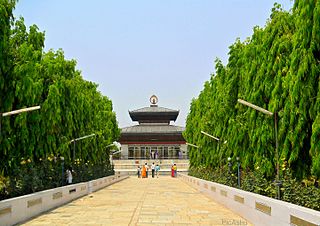
Mithila, also known as Tirhut, Tirabhukti and Mithilanchal is a geographical and cultural region of the Indian subcontinent bounded by the Mahananda River in the east, the Ganges in the south, the Gandaki River in the west and by the foothills of the Himalayas in the north. It comprises certain parts of Bihar and Jharkhand of India and adjoining districts of the Province No. 1, Bagmati Pradesh and Madhesh Province of Nepal. The native language in Mithila is Maithili, and its speakers are referred to as Maithils.
Mithila culture or Maithil culture refers to the culture which originated in the Mithila region of the Indian subcontinent. Mithila comprises Tirhut, Darbhanga, Kosi, Purnia, Munger, Bhagalpur and Santhal Pargana divisions of India and adjoining provinces of Province No. 1, Bagmati Pradesh, and Madhesh Province of Nepal.

Hinduism is the largest religious tradition in the Indian state of West Bengal with approximately 70.5% of the population identifying themselves as Hindus. The Hindus in West Bengal mostly belong to the Shakta, minority to Vaishnavite and a small community belong to Shaivite and other denominations. The vast majority of Hindus in West Bengal are Bengali Hindus numbering around 55 million and comprising 60.2% of the state population of 91.35 million (2011) but a notable section of non-Bengali Hindus also exist, particularly among Marwaris, Biharis, Odias, Gurkhas, Sindhis, Gujaratis and various tribal communities such as Koch, Santals, Munda and particularly Adivadis numbering around 9.4 million comprising rest 10.3% of the state population.Hindus have decreased in west bengal due to conversion to Islam which National Commission for Backward Classess(NCBC) notices.

Angika is an Eastern Indo-Aryan language spoken in some parts of the Indian states of Bihar and Jharkhand, as well as in parts of Nepal.
Here is a list of glossary of Culture of India in alphabetical order:
Sheetala Ashtami or Sheetalasthami is a Hindu festival in honor of the goddess Shitala or Sheetala, celebrated on the eighth day (ashtami) after the festival of colors, Holi.

















